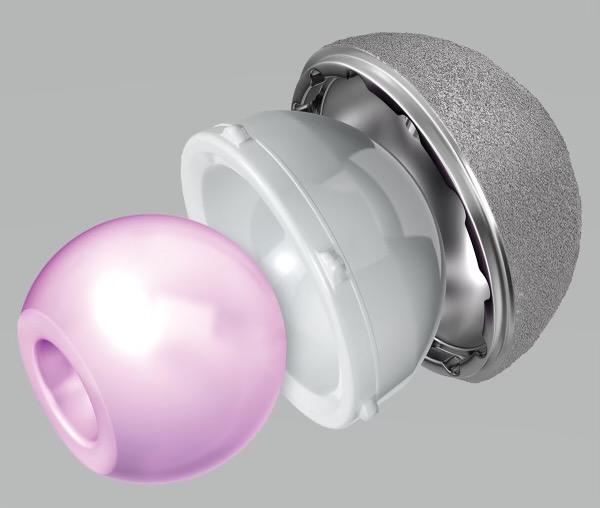Total Hip Joint Replacement
You Don’t Have to Live with Joint Pain
Your joints are involved in almost every activity you do. Simple movements such as walking, bending, and turning require the use of your hip and knee joints. Normally, all parts of these joints work together and the joint moves easily without pain. But when the joint becomes diseased or injured, the resulting pain can severely limit your ability to move and work. Osteoarthritis, one of the most common forms of degenerative joint disease, affects an estimated 43 million people in the United States.1 Whether you are considering a total joint replacement, or are just beginning to explore available treatments, this website is for you. It will help you understand the causes of joint pain and treatment options. Most importantly, it will give you hope that you may be able to return to your favorite activities.
Once you’re through reading this website, be sure to ask your doctor any questions you may have. Gaining as much knowledge as possible will help you choose the best course of treatment to relieve your joint pain — and get you back into the swing of things.
What is a Hip Joint?
 Your hip joint is a ball-and-socket joint, formed by the ball, or femoral head, at the upper end of the thighbone, and the rounded socket, or acetabulum, in the pelvis. The bone ends of a joint are covered with a smooth, tough material called cartilage. Normal cartilage cushions the bones and allows nearly frictionless and pain-free movement. The rest of the surfaces of the joint are covered by a thin, smooth tissue lining called the synovium. The synovium produces fluid that acts as a lubricant to reduce friction and wear in the joint.
Your hip joint is a ball-and-socket joint, formed by the ball, or femoral head, at the upper end of the thighbone, and the rounded socket, or acetabulum, in the pelvis. The bone ends of a joint are covered with a smooth, tough material called cartilage. Normal cartilage cushions the bones and allows nearly frictionless and pain-free movement. The rest of the surfaces of the joint are covered by a thin, smooth tissue lining called the synovium. The synovium produces fluid that acts as a lubricant to reduce friction and wear in the joint.
Common Causes of Joint Pain
Osteoarthritis (OA)
Sometimes called degenerative arthritis because it is a “wearing out” condition involving the breakdown of cartilage and bones. When cartilage wears away, the bones rub against each other, causing pain and stiffness. OA usually occurs in people aged 50 years and older, and frequently in individuals with a family history of arthritis.

Rheumatoid Arthritis (RA)
Causes the synovium to become thickened and inflamed. In turn, too much synovial fluid is produced within the joint space, which causes a chronic inflammation that damages the cartilage. This results in cartilage loss, pain, and stiffness. RA affects women about 3 times more often than men, and may affect other organs of the body.
Post-traumatic Arthritis
May develop after an injury to the joint in which the bone and cartilage do not heal properly. The joint is no longer smooth and these irregularities lead to more wear on the joint.
Avascular Necrosis
Can result when bone is deprived of its normal blood supply. Without proper nutrition from the blood, the bone’s structure weakens and may collapse and damage the cartilage.
Paget’s Disease
A bone disease that often affects the hip. Bone formation is sped up, causing the density and shape of the bone to change. Joint pain can also be caused by deformity or direct injury to the joint. In some cases, joint pain is made worse by the fact that a person will avoid using a painful joint, weakening the muscles and making the joint even more difficult to move.
Treatment Options
Following the orthopaedic evaluation, your orthopaedic surgeon will review and discuss the results with you. Based on his or her diagnosis, your treatment options may include:
- Medication
- Joint fluid supplements
- Physical therapy
- Joint replacement
Total Hip Replacement
 Hip replacement is one of the most important surgical advances of this century. This surgery helps more than 300,000 Americans each year2 to relieve their pain, and get back to enjoying normal, everyday activities. Hip replacement involves the removal of arthritic bone ends and damaged cartilage and replacing them with prosthetic implants that replicate the hip joint.
Hip replacement is one of the most important surgical advances of this century. This surgery helps more than 300,000 Americans each year2 to relieve their pain, and get back to enjoying normal, everyday activities. Hip replacement involves the removal of arthritic bone ends and damaged cartilage and replacing them with prosthetic implants that replicate the hip joint.
Hip replacement surgery may be considered when arthritis limits your everyday activities such as walking and bending, when pain continues while resting, or stiffness in your hip limits your ability to move or lift your leg. Hip replacement may be recommended only after careful diagnosis of your joint problem. It is time to consider surgery if you have little pain relief from anti-inflammatory drugs or other treatments, such as physical therapy, do not relieve hip pain. Hip replacement can help relieve pain and get you back to enjoying normal, everyday activities.
Total hip replacement is often reserved for patients who:
- Have a painful, disabling joint disease of the hip resulting from a severe form of arthritis
- Are not likely to achieve satisfactory results from less invasive procedures, such as arthrodesis (artificial stiffening or fixation of the joint)
- Have bone stock that is of poor quality or inadequate for other reconstructive techniques
In a total hip replacement operation, the surgeon replaces the worn surfaces of the hip joint with an artificial hip joint. The worn head of the femur (thigh bone) is replaced with a metal or ceramic ball mounted on a stem; the stem is placed firmly into the canal of the thigh bone at its upper end. The acetabulum (hip socket) is prepared and implanted with a metal cup and plastic or ceramic insert. The ball and insert glide together to replicate the hip joint.
Total Hip Implants
The conventional arrangement of a metal ball into a special plastic (polyethylene) cup has been shown to have positive results over the years. How long it will last depends not only on age, but also on a patient’s activity level.
Another factor that may affect the durability of a total hip replacement is the bearing surface. The bearings are the two parts of the artificial hip that glide together throughout motion. These bearings can be metal-on-polyethylene, metal-on-metal, ceramic-on-polyethylene or ceramic-on-ceramic.
Technologies That May Impact Implant Performance
There have been significant advancements in improving the bearing surfaces in total hip replacement. Ceramic-on-ceramic bearings provide superior wear performance.3 Stryker’s ceramic-on-ceramic system has demonstrated significantly lower wear than metal-on-polyethylene systems in the laboratory; therefore, it is anticipated that these improved wear characteristics may extend the life of the implant.
There are also new, advanced polyethylene implants available that have demonstrated extremely low wear in the laboratory, and they are expected, over time, to have similar wear performance clinically.4
Your physician will discuss the exact type of prosthesis and surgical procedure with you.
Complications of Hip Replacement
As with any surgery, there is risk of complications after hip replacement surgery. However, they are relatively rare. Blood clots are the most common complication after surgery. Your orthopaedic specialist may prescribe one or more measures to prevent a clot from forming in your leg veins. These measures may include special support hose, inflatable leg coverings and blood thinners.
Recovery
Generally, after hip replacement surgery, you may spend approximately 3 to 5 days in the hospital. Most hip replacement patients begin standing and walking with the help of a walker and a physical therapist the day after surgery.
Recovery varies with each person. It is essential that you follow your orthopaedic surgeon’s instructions regarding home care during the first few weeks after surgery; especially the exercise program you are prescribed. You should be able to resume many normal light activities of daily living within 3 to 6 weeks following surgery. Some discomfort with activity, and at night, is common for several weeks. Complete recovery can take from about 3 to 6 months.
While most people will gradually increase their activities and play golf, doubles tennis, shuffleboard or bowling, you will be advised to avoid more active sports, such as jogging, singles tennis and other high impact activities.
You Don’t Have to Live with Severe Hip Pain
You don’t have to live with severe hip pain and the limitations it puts on your activities. If you haven’t experienced adequate relief with medication and other conservative treatments, Hip Joint Replacement may provide the pain relief you long for and enable you to return to your favorite activities. Remember, even if your doctor recommends hip replacement for you, it is still up to you to make the final decision.
For more information contact Dr. Ingram.
Stryker Corporation or its divisions or other corporate affiliated entities own, use or have applied for the following trademarks or service marks: Accolade, Stryker, Trident and TMZF. All other trademarks are trademarks of their respective owners or holders.
References:
- Arthritis Foundation website, Feb. 2006.
- Orthopedics.about.com website, Feb. 2006.
- Taylor. S.K., Serekian, P., Manley, M., “Wear Performance of a Contemporary Alumina: Alumina Bearing Couple under Hip Joint Simulation,” Trans. 44th Ann. Mtg. ORS, 1998.
- Stryker Test Report RD–04–099.








